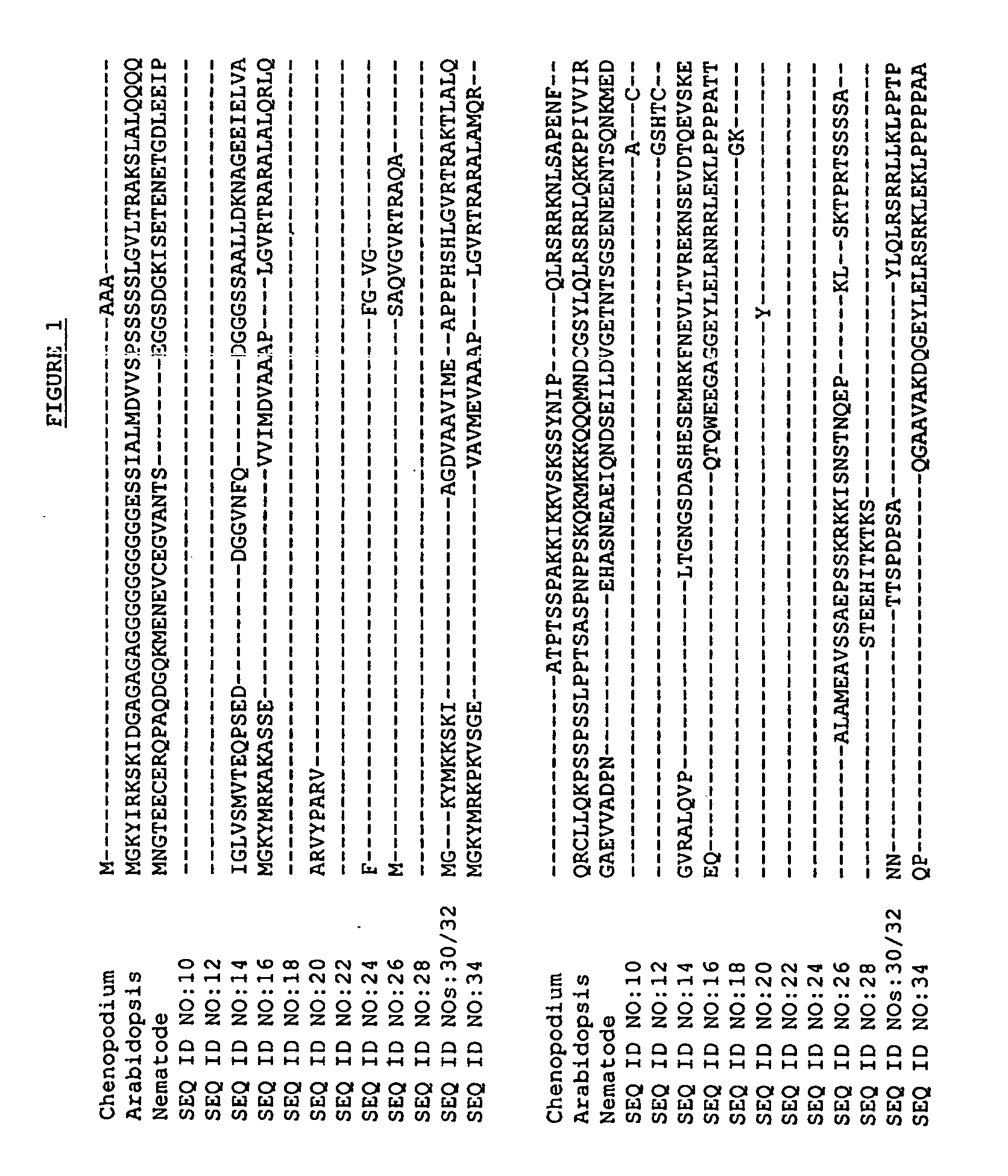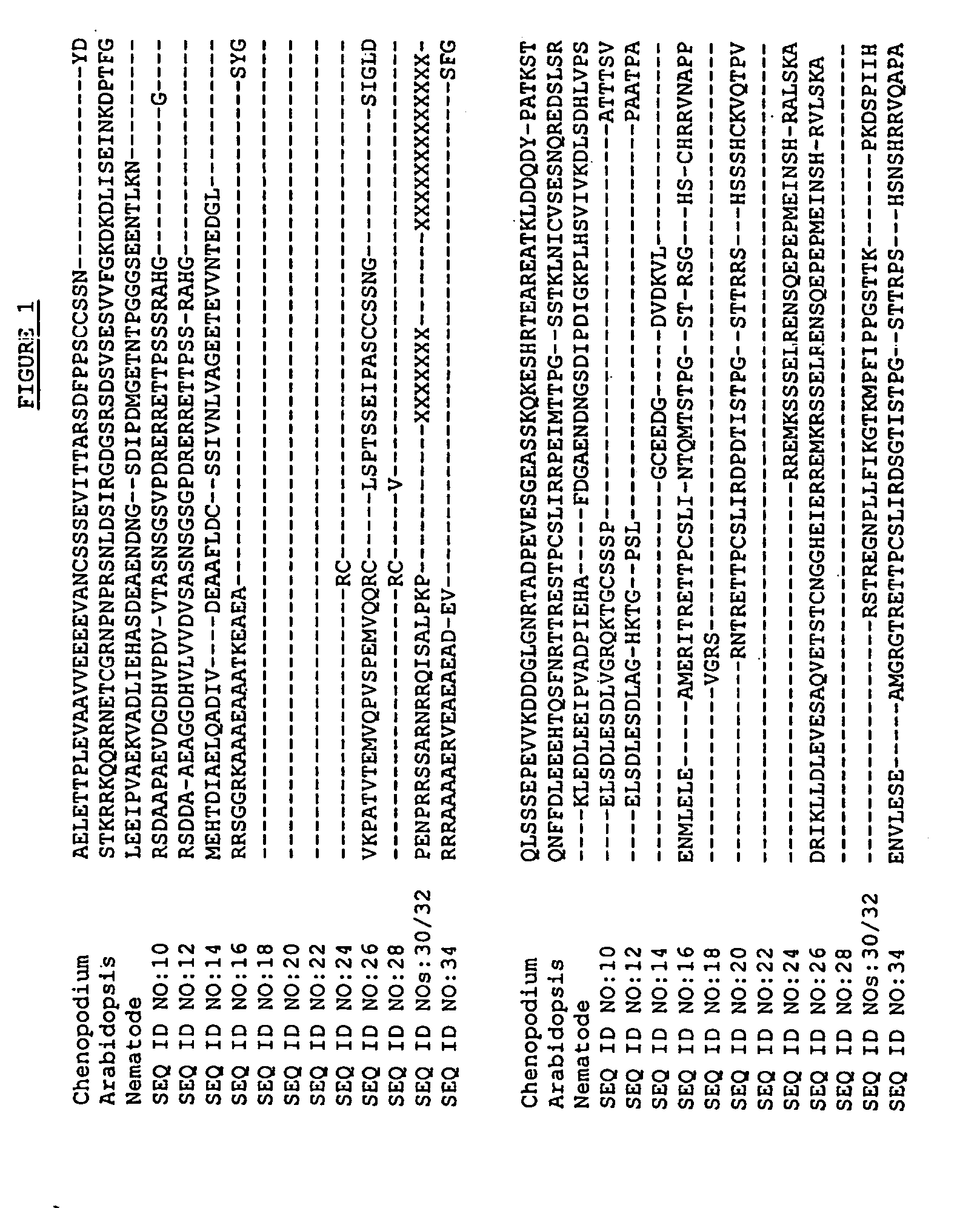Cell cycle genes in plants
- Summary
- Abstract
- Description
- Claims
- Application Information
AI Technical Summary
Benefits of technology
Problems solved by technology
Method used
Image
Examples
example 1
Composition of cDNA Libraries: Isolation and Sequencing of cDNA Clones
[0081] cDNA libraries representing mRNAs from various corn, rice, soybean, and wheat tissues were prepared. The characteristics of the libraries are described below.
TABLE 2cDNA Libraries from Corn, Rice, Soybean, and WheatLibraryTissueClonecbn2nCorn Developing Kernel Two Days After Pollination*cbn2n.pk0010.h7cen3nCorn Endosperm 20 Days After Pollination*cen3n.pk0013.cp,cen3n.pk0115.a6,cen3n.pk0151.d2cr1nCorn Root From 7 Day Old Seedlings*cr1n.pk0052.f11,cr1n.pk0195.b3cs1Corn Leaf Sheath From 5 Week Old Plantcs1.pk0068.c12csi1nCorn Silk*csi1n.pk0050.e6,csi1n.pk0050.e6:fiscta1nCorn Tassel*cta1n.pk0070.d4p0023Leaf: Gene M1C07 (leucine-rich repeat), family 3-B7,p0023.clrag76rinduces resistance prior to genetic lesion formation. aboutone month after planting in green housep0058Honey N pearl (sweet corn hybrid) shoot culture. It wasp0058.chpbm23rbinitiated on 2 / 28 / 96 from seed derived meristems. Theculture was mainta...
example 2
Identification of cDNA Clones
[0083] cDNA clones encoding CDKI were identified by conducting BLAST (Basic Local Alignment Search Tool; Altschul et al. (1993) J. Mol. Biol. 215:403-410; see also www.ncbi.nlm.nih.gov / BLAST / ) searches for similarity to sequences contained in the BLAST “nr” database (comprising all non-redundant GenBank CDS translations, sequences derived from the 3-dimensional structure Brookhaven Protein Data Bank, the last major release of the SWISS-PROT protein sequence database, EMBL, and DDBJ databases). The cDNA sequences obtained in Example 1 were analyzed for similarity to all publicly available DNA sequences contained in the “nr” database using the BLASTN algorithm provided by the National Center for Biotechnology Information (NCBI). The DNA sequences were translated in all reading frames and compared for similarity to all publicly available protein sequences contained in the “nr” database using the BLASTX algorithm (Gish and States (1993) Nat. Genet. 3:266-27...
example 3
Characterization of cDNA Clones Encoding Cyclin Dependent Kinase Inhibitors
[0084] The BLASTX search using the EST sequences from clones listed in Table 3 revealed similarity of the polypeptides encoded by the cDNAs to CDKIs from the flowering short-day plant Chenopodium [Chenopodium rubrum] (NCBI Accession No. gi 2653281), the nematode [Caenorhabditis elegans] (NCBI Accession No. gi 2731583), and the flowering weed Arabidopsis [Arabidopsis thaliana] (NCBI Accession No. gi 2914702). Shown in Table 3 are the BLAST results for individual ESTs (“EST”), the sequences of the entire cDNA inserts comprising the indicated cDNA clones (“FIS”), contigs assembled from two or more ESTs (“Contig”), contigs assembled from an FIS and one or more ESTs (“Contig*”), or sequences encoding the entire protein derived from an FIS, a contig, or an FIS and PCR (“CGS”):
TABLE 3BLAST Results for Sequences Encoding Polypeptides Homologousto Cyclin Dependent Kinase InhibitorsBLASTpLog ScoreCloneStatus26532812...
PUM
| Property | Measurement | Unit |
|---|---|---|
| Fraction | aaaaa | aaaaa |
| Fraction | aaaaa | aaaaa |
| Fraction | aaaaa | aaaaa |
Abstract
Description
Claims
Application Information
 Login to View More
Login to View More - R&D
- Intellectual Property
- Life Sciences
- Materials
- Tech Scout
- Unparalleled Data Quality
- Higher Quality Content
- 60% Fewer Hallucinations
Browse by: Latest US Patents, China's latest patents, Technical Efficacy Thesaurus, Application Domain, Technology Topic, Popular Technical Reports.
© 2025 PatSnap. All rights reserved.Legal|Privacy policy|Modern Slavery Act Transparency Statement|Sitemap|About US| Contact US: help@patsnap.com



